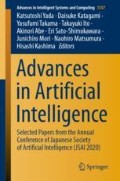Abstract
Most current research on robotic tasks such as grasping uses the single fixed viewpoint positioned to oversee the environment from above. However, there are cases when a single fixed viewpoint does not provide sufficient information to perform a designated robot task. Environments with high occlusion, or cases where objects have fragile components, it is difficult for robots to identify the task relevant viewpoint to achieve a task or goal. Herein, to reconstruct the world model with less effort, we propose a viewpoint planner method that uses uncertainty in scene representation from Generative Query Network(GQN) With this scene representation, we create an uncertainty map by calculating the pixel-wise variance of multiple predicted images for each query viewpoint. The results indicate that our solution is capable of taking a suitable view of an untrained object, therefore reducing the uncertainty. A suitable viewpoint is defined as one that improves prediction certainty by focusing an area in which the learning environment allows the highest uncertainty value. In a future study, we would like to propose a task specific viewpoint planner models for robotic tasks such as grasping objects with occlusion by extending this research.
Access this chapter
Tax calculation will be finalised at checkout
Purchases are for personal use only
References
Bajcsy, R.: Active perception. Proc. IEEE 76(8), 966–1005 (1988)
Bohg, J., Morales, A., Asfour, T., Kragic, D.: Data-driven grasp synthesis-a survey. IEEE Trans. Rob. 30(2), 289–309 (2014)
Chen, S., Li, Y., Kwok, N.: Active vision in robotic systems: a survey of recent developments. Int. J. Robot. Res. 30, 1343–1377 (2011)
Eslami, S.M.A., et al.: Neural scene representation and rendering. Science 360(6394), 1204–1210 (2018)
Gregor, K., Danihelka, I., Graves, A., Wierstra, D.: DRAW: a recurrent neural network for image generation. CoRR, abs/1502.04623 (2015)
Kappler, D., Bohg, J., Schaal, S.: Leveraging big data for grasp planning. In: 2015 IEEE International Conference on Robotics and Automation (ICRA), pp. 4304–4311 (2015)
Lenz, I., Lee, H., Saxena, A.: Deep learning for detecting robotic grasps. Int. J. Robot. Res. 34(4–5), 705–724 (2015)
Levine, S., Pastor, P., Krizhevsky, A., Ibarz, J., Quillen, D.: Learning hand-eye coordination for robotic grasping with deep learning and large-scale data collection. Int. J. Robot. Res. 37(4–5), 421–436 (2018)
Mahler, J., et al.: Dex-Net 2.0: deep learning to plan robust grasps with synthetic point clouds and analytic grasp metrics (2017)
Mahler, J., Matl, M., Liu, X., Li, A., Gealy, D., Goldberg, K.: Dex-Net 3.0: computing robust robot suction grasp targets in point clouds using a new analytic model and deep learning. arXiv preprint arXiv:1709.06670 (2017)
Mahler, J., et al.: Learning ambidextrous robot grasping policies. Sci. Robot. 4(26), eaau4984 (2019)
Manuelli, L., Gao, W., Florence, P., Tedrake, R.: kPAM: keypoint affordances for category-level robotic manipulation. arXiv, abs/1903.06684 (2019
Nguyen-Phuoc, T., Li, C., Theis, L., Richardt, C., Yang, Y.: HoloGAN: unsupervised learning of 3D representations from natural images. CoRR, abs/1904.01326 (2019)
Qiu, Y., Satoh, Y., Suzuki, R., Iwata, K., Kataoka, H.: Multi-view visual question answering with active viewpoint selection. Sensors 20(8), 2281 (2020)
Rasouli, A., Tsotsos, J.K.: The effect of color space selection on detectability and discriminability of colored objects. CoRR, abs/1702.05421 (2017)
Sather, J., Zhang, X.J.: Viewpoint optimization for autonomous strawberry harvesting with deep reinforcement learning. arXiv, abs/1903.02074 (2019)
Sitzmann, V., Zollhöfer, M., Wetzstein, G.: Scene representation networks: continuous 3D-structure-aware neural scene representations. CoRR, abs/1906.01618 (2019)
Tobin, J., OpenAI, Abbeel, P.: Geometry-aware neural rendering. arXiv, abs/1911.04554 (2019)
Acknowledgment
This work was supported by Japan Science and Technology Agency (JST) CREST Grant Number JPMJCR15E3 “Symbol Emergence in Robotics for Future Human-Machine Collaboration”, Japan.
Author information
Authors and Affiliations
Corresponding author
Editor information
Editors and Affiliations
Rights and permissions
Copyright information
© 2021 The Author(s), under exclusive license to Springer Nature Switzerland AG
About this paper
Cite this paper
Lukman, K., Mori, H., Ogata, T. (2021). Viewpoint Planning Based on Uncertainty Maps Created from the Generative Query Network. In: Yada, K., et al. Advances in Artificial Intelligence. JSAI 2020. Advances in Intelligent Systems and Computing, vol 1357. Springer, Cham. https://doi.org/10.1007/978-3-030-73113-7_4
Download citation
DOI: https://doi.org/10.1007/978-3-030-73113-7_4
Published:
Publisher Name: Springer, Cham
Print ISBN: 978-3-030-73112-0
Online ISBN: 978-3-030-73113-7
eBook Packages: Intelligent Technologies and RoboticsIntelligent Technologies and Robotics (R0)

